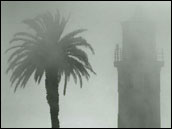

Signs of Drizzle | |||
So what might these elaborate features mean to weather systems and climate patterns? Unfortunately, there’s no simple answer, according to Garay. “Clouds trace atmospheric motion, so they’re responding to the atmosphere in a complicated way,” said Garay. Clouds are complex: they change in response to small-scale effects, like the presence of a hill or the local wind, but they also respond to large-scale weather systems, such as cold fronts and the presence of the jet stream, said Garay. Stevens, who studies a closely related cloud form dubbed “pockets of open cells,” or POCs, has a theory that may begin to explain the complex interactions between clouds and the climate system: he thinks they may be linked to drizzle. Both POCs and actinoform clouds have a compact and distinct shape embedded within low-level marine stratus clouds. But the taxonomy to determine the exact relationship between actinoform clouds and POCs hasn’t yet been worked out. “How similar they are is an open question,” said Stevens. |
|||
 | |||
The open cells that Stevens studies are one of two well-known types of stratocumulus cloud formations: open and closed cells. Open cells resemble a honeycomb, with clouds around the edges and clear, open space in the middle. Closed cells are cloudy in the center and clear on the edges, similar to a filled honeycomb. Like actinoform clouds, the ‘cells’ in this case do not refer to a single cloud but to the system of associated clouds. Previously, researchers believed that actinoform clouds represented a transitional form between open and closed cells, but the recent findings on actinoform clouds show that they are clouds in their own right. Each year, Southern Californians experience a long cycle of dreary, overcast days known as May Gray and June Gloom. Scientists are learning that regions where these systems occur are good hunting grounds for actinoform cloud formations. Stevens’ observations from field studies in the Pacific seem to indicate that when marine stratus clouds exist alone, in the absence of these open cells, the cloud formations are associated with little, or no, drizzle. Yet when the open cells are present—and likewise actinoform clouds—there seems to be a corresponding increase in drizzle. Thus, his data suggest that the presence of POCs and actinoform clouds is related to the onset of precipitation. “The shape of the cloud field reorganizes itself when the clouds begin to rain,” said Stevens. In fact, Stevens has been able to mirror this reorganization using a computer model of a drizzling cloud field. |
This Moderate Resolution Imaging Spectroradiometer (MODIS) image shows open-cell (stretched horizontally through image center from upper left), closed-cell (top and bottom), and actinoform clouds (lower left) off the coast of Peru. (Image courtesy Jacques Descloitres, MODIS Rapid Response Team, NASA GSFC) | ||
Stevens’ findings are a good example of the important role that clouds play in regulating climate. Clouds reflect incoming sunlight, and they also act as a blanket that slows the upward movement of heat from Earth’s surface back into space. This is why cloudy days are generally cooler than sunny days, but cloudy nights are generally warmer than clear nights. Thus, cloud cover is instrumental in setting Earth’s energy balance and controlling its internal “body” temperature. “It makes the observation of these peculiar cloud forms, which seem to be linked to the development of precipitation, more interesting than they would’ve otherwise been,” said Stevens. For those of us who spent some of our childhood days lying with our backs in the grass and gazing at the sky, the prevalence of unexpected cloud features in the sky might not come as a particular surprise. But for scientists, it raises the question of whether looking for patterns in the clouds might help unveil some of the deeper mysteries of the climate system. Either way, it appears that these clouds will continue to puzzle children and scientists alike. “It’s really kind of fascinating,” said Garay. “You’d expect these clouds to be sort of round or flat. But looking like a wheel with spokes coming out of them is just kind of surprising.” |

“May Gray” and “June Gloom” conditions cause heavy fog to hug the California coast, making for cool daytime temperatures. (Image courtesy NOAA) | ||